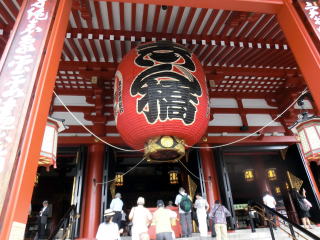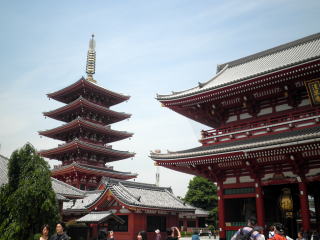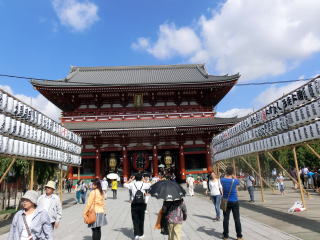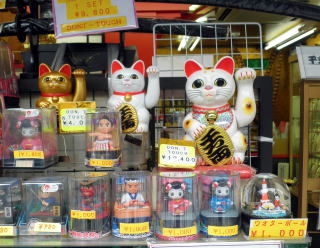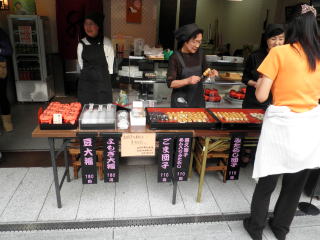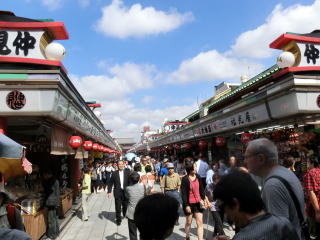SENSO-JI Buddhist temple and NAKAMISE street with a hundred of shops
We visit Asakusa by the train of Ginza subway line taking 16 minutes from
the Ginza station
via Ueno. Asakusa is the most visited place by foreign and Japanese tourists
in Tokyo and
always full of them. In Asakusa, there are the Senso-ji Buddhist temple,
Sanja Shinto shrine,
Asakusa Hana-yashiki amusement park, Nakamise street with about hundred of shops
at the both sides of the approach to the temple and so on.
Senso-ji temple was originally built by Mr. Hajino Nakamoto, the chief
of the district in 628
so as to enshrine a small golden statue of Bodhisattva (2 inches), which
Hinokuma brothers,
two fishermen found by accident in their fishing net in the nearby Sumida river.
During the Edo period, Senso-ji temple enjoyed financial support by Tokugawa
shoguns
and added many installations.
However almost all buildings except Niten-mon gate were destroyed by American
air raids
in 1945 and reconstructed in 1958.
This is NITEN-MON gate built in 1618 and
only remains original and intact.
This is the Buddhist altar, under which
they saythe golden statue is placed.
They sell Japanese samurai's imitation swords
They sell traditional dumplings coated with
red bean paste, sesame paste, etc.
This is the apparoch to the temple of Sensoji
with hundreds of stores at the both sides,
which we call "Nakamise".
This is KAMINARI-MON gate to Senso-ji
Buddhist temple which literally means
Thunder gate.
From the intersection above the Asakusa station
of Ginza subway line, you can see Sky tree of
634 meters and Asahi beer company's building
with golden walls and the object " flame of gold"
on the annex.
Getting out of Asakusa subway station, we can
find two portable shrines in a showcase at the
basement. These portable shrines are for Sanja
festival in May to worship the three gentlemen,
Mr. Hajino Nakamoto and Hinokuma brothers.
These are pictures on the ceiling
such as Buddhist angle, dragon, etc.
This is the front of Senso-ji Buddhist temple.
This is a place where people purify
themselves with spring water before
making presentation before deity.
This is a big incense burner and people
believe that its smoke has magic power
to cure sickness.
Here written fortunes are sold at 100 yen.
This is the front of Senso-ji temple.
A little before reaching HOZO-MON
gate, you see a big five story pagoda
at the left of the gate.
This is an inner gate, Hozo-mon,
constructed in 1964.
They sell Japanese traditional wear, kimono.
They sell Maneki-neko, which literally means
a doll cat to invite good fortune and/or money.
They sell traditional masks such as
HYOTTOKO y OKAME for the traditional
theater dance.
They sell traditional Japanese footwear
such as Zori, Geta, etc.




